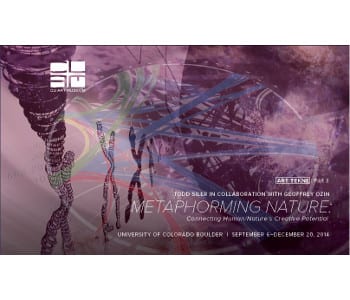 The collaboration between artscientist Todd Siler and nanoscientist Geoffrey Ozin began with a shared interest in how the integration of art and science can generate innovative frameworks for a sustainable future. With the global population predicted to reach 9.6 billion by 2050, accompanied by mounting demand for fossil fuels to spur economic growth, the fate of humankind seems tenuous at best. Ozin’s research into nanochemistry, however, suggests an antidote to the fear of environmental collapse and mass extinction. If nanotechnology can mimic a process like photosynthesis in plants then carbon dioxide ceases to be a noxious gas and becomes a resource. Siler’s art gives form to these concepts, particularly how the brain interacts with nature as it connects and transforms everything nature creates in personally meaningful and purposeful ways.
The collaboration between artscientist Todd Siler and nanoscientist Geoffrey Ozin began with a shared interest in how the integration of art and science can generate innovative frameworks for a sustainable future. With the global population predicted to reach 9.6 billion by 2050, accompanied by mounting demand for fossil fuels to spur economic growth, the fate of humankind seems tenuous at best. Ozin’s research into nanochemistry, however, suggests an antidote to the fear of environmental collapse and mass extinction. If nanotechnology can mimic a process like photosynthesis in plants then carbon dioxide ceases to be a noxious gas and becomes a resource. Siler’s art gives form to these concepts, particularly how the brain interacts with nature as it connects and transforms everything nature creates in personally meaningful and purposeful ways.
At the CU Art Museum, Siler’s large-scale installation Metaphorming Nature features a selection of artworks that interpret what nature makes and what we make of nature. The installation replicates the limbic system – the heart of the human brain – where intuitions, feelings and emotions, including fear, are integrated and interpreted. The immersive environment presents a mosaic of interrelated paintings, sculptures, drawings, and photomontages produced over the last four decades. Other artworks visualize nano-scale and macro-scale processes and physical matter, in which sparks between atoms seem to transform into a cosmos of possibilities. With no stabilizing horizon line, the large swathes of fiery reds and cool blues at play in these paintings impact cognition and also activate in the mind fear of the unknown and the boundless represented by the infinitesimal and infinite. Likewise, Ozin’s research into new nanotechnology with global ramifications on renewable energy solutions to climate change through the paradigm of a new carbon dioxide economy is at once hopeful and a little bit scary.


















